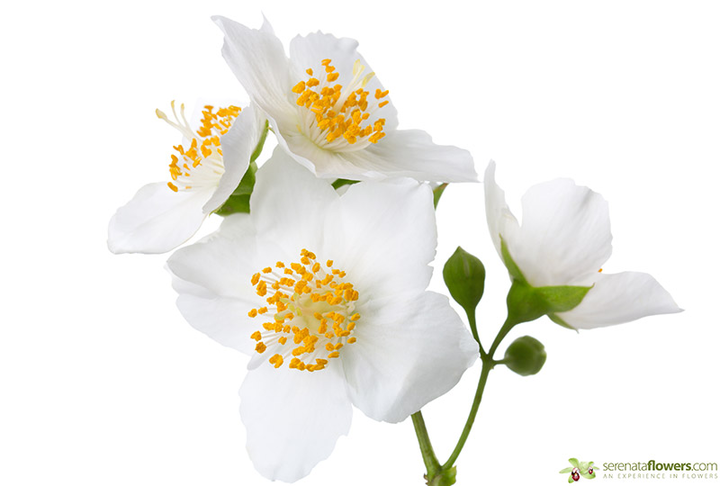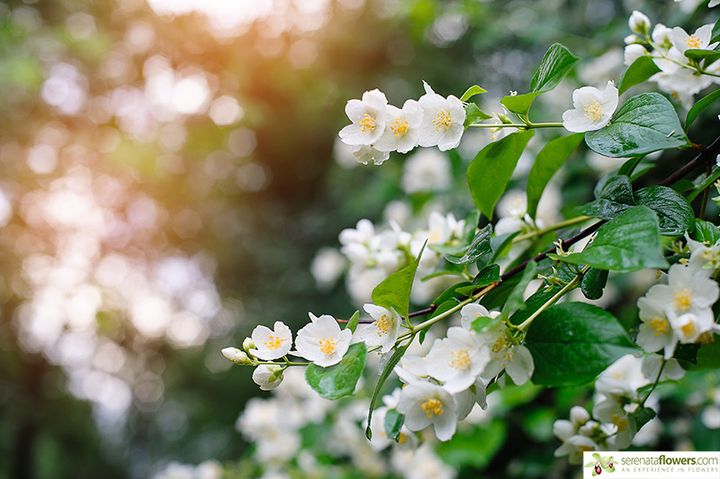
The jasmine plant is a genus of vines and shrubs from the olive family (botanical name Oleaceae).
There are an impressive 200 species in existence, many of which are native to warm, tropical climates and regions including Australasia, Eurasia and Oceania.
The main reason for this plant’s popularity is its characteristic fragrance.
Description
The jasmine flower is either deciduous (which means the leaves fall in the autumn) or evergreen (which means the leaves are green all year round).
Certain species stand tall, while others spread or climb. The flowers typically measure 2.5 cm in diameter and boast hues of white and yellow.
Certain species however are reddish in colour, although this is quite rare.
The flowers are borne in cymose clusters and showcase at least three flowers.
Each flower has between four and nine petals, four ovules and two locules.
They have two stamens brandishing extremely short filaments, with linear or ovate bracts, with a bell-shaped calyx.
Jasmine flowers also boast fruits in the shape of berries that change to black when ripe.
Habitat
Although native to subtropical regions, a number of jasmine species have become naturalised in Mediterranean Europe. One of these species is Spanish jasmine (botanical name, Jasminum grandiflorum).
This particular variant was originally sourced from Iran and western South Asia, and is now grown in the Iberian Peninsula.
Other popular species include Jasminum fluminense (also known as “Brazilian Jasmine“) and Jasminum dichotomum (Gold Coast Jasmine) – both are invasive species grown in Florida and Hawaii.
Jasminum polyanthum, (White Jasmine), is another invasive specie, which is actually treated as a weed in Australia.
Cultivation and uses

Jasmine flowers are widely cultivated for their blooms, and are a popular garden and house plant.
In certain parts of the world, particularly in South East Asia, the flowers are worn by women in their hair.
Jasmine tea
Green tea with jasmine flowers is a prevalent tea blend, consumed in China and other parts of the world.
It is often called jasmine flower tea. Jasminium Samba flowers are used to make this particular beverage, which has a base of white, green tea or oolong.
In order to create this tea, flowers are placed in machines that control both the humidity and temperature.
It takes around four hours for the tea to absorb the jasmine flower fragrance.
This process is sometimes repeated up to seven times in order to create the highest grades of jasmine tea.
Cultural importance
A city located in Tamil Nadu called Madurai is famed for its jasmine production.
Other areas where this flower can be found include the western and southern states of India, including Karnataka, Maharashtra, Andhra Pradesh, Kerala and Tamil Nadu.
It’s not uncommon for jasmine flowers to be cultivated in private homes in these areas.
In addition to teas, these flowers are also used as hair embellishments and in worship in marriage rituals, religious ceremonies and festivals.
Jasmine flowers are also cultivated commercially, for both industrial and domestic use, including for the likes of perfume.
In the Chandan Yatra, the deity is bathed with water flavoured with jasmine and sandalwood.
A national flower
Several states and countries consider the jasmine flower to be their national flower, including:
·Hawaii: Jasminium Sambac (also known as “pikake“) is one of the area’s most prevalent flowers, often used in leis and is the subject of many songs.
·Pakistan: Jasminium Officinale (also known as “chambeli” or “yasmin“), is the city’s national flower.
·Indonesia: Jasminium Sambac is also Indonesia’s national flower. It was adopted in 1990 and is locally known as “melati putih“. It’s used in wedding ceremonies for ethnic Indonesians, particularly on the island of Java.
·Thailand: Jasmine flowers are symbolic of motherhood.
·Philippines: Jasminimum Sambac was adopted in 1935, and is known as sampaguita by the locals. It is usually strung in garlands, used to decorate religious images.
·Syria: The Syrian city Damascus, also known as the City of Jasmine, holds this flower as a symbol.
The jasmine plant is a source of exotic fragrance in warmer climates.
It is an important scent noted in perfumes and has herbal properties.
The plants may be vines or bushes and some are evergreen.
Most jasmine plants are found in tropical to sub-tropical climates, although a few may thrive in temperate zones.
Protection from cold temperatures is one of the most important aspects of jasmine plant care.
Growing jasmine vines can create a perfumed shield over arbors, trellises and fences.
The bush types are excellent landscape specimens with starry pink, white, ivory or even yellow scented blooms.
Jasmine plant care

Although this plant requires a little maintenance, it’s well worth the effort.
Not all jasmine plants are perfumed, however the most prevalent blooms are both hardy and sweet-smelling.
Popular variants
The most common jasmine flowers come in vine-form and boast larger, rich glossy green leaves.
Royal jasmine, on the other hand, is less showy.
If plated in a sheltered area, both can survive in temperate climates. Arabian jasmine, another popular specie, comes in the shape of a small bush with evergreen leaves.
There are various other types of jasmine plant available, many of which are best suited to sub-tropical climates.
All promise to add a striking visual to any indoor or outdoor space.
Top tips for growing Jasmine flowers
·Select a warm, sheltered area and use a structure of some sort when growing the vining varieties, as these particular plants can grow to an impressive 15 feet tall.
·All jasmine plants enjoy sunny sites and should be placed in well-draining, moderately fertile soil.
·Place the plant in the ground at the same level it grew at in its nursery pot.
Jasmine flower care
·Jasmine plant care isn’t difficult, but it is time-consuming. This is particularly the case when growing vines, as they need to be trained when they are young. You can use ties or a trellis to achieve this.
·For best results, fertilize the plants in the spring months, prior to new growth appearing.
·Pinch off the tips of the vines in the second year to encourage new growth.
·Beware of pests such as spider mites. If you notice these attacking your plant, use neem or horticultural oil to attack the pests.
Indoor Jasmine Care
·Dwarf varieties of jasmine are best used as houseplants. They require a sunny spot and even moisture.
·Vines can also be grown in the home. You can control the height through pruning or pinching in the dormant season.
·When growing jasmine flowers in pots, remember to fertilize twice annually.
· Beware of pests and water from the bottom to prevent the glossy leaves from spotting.